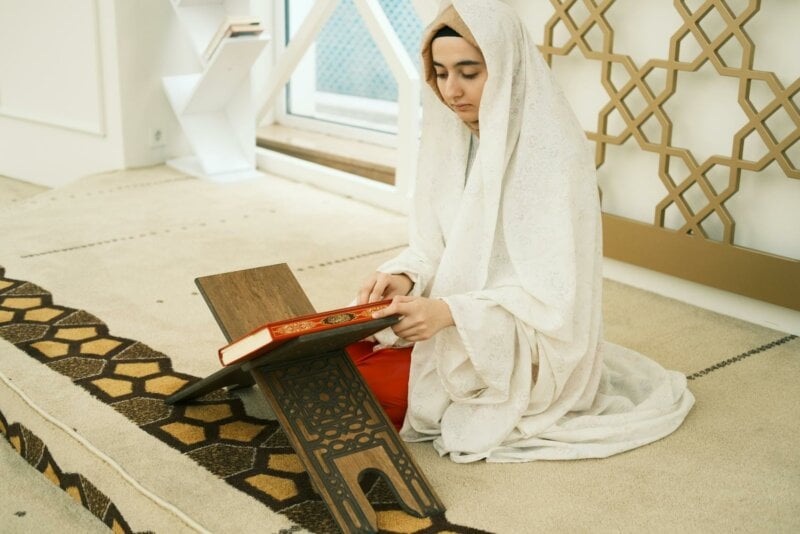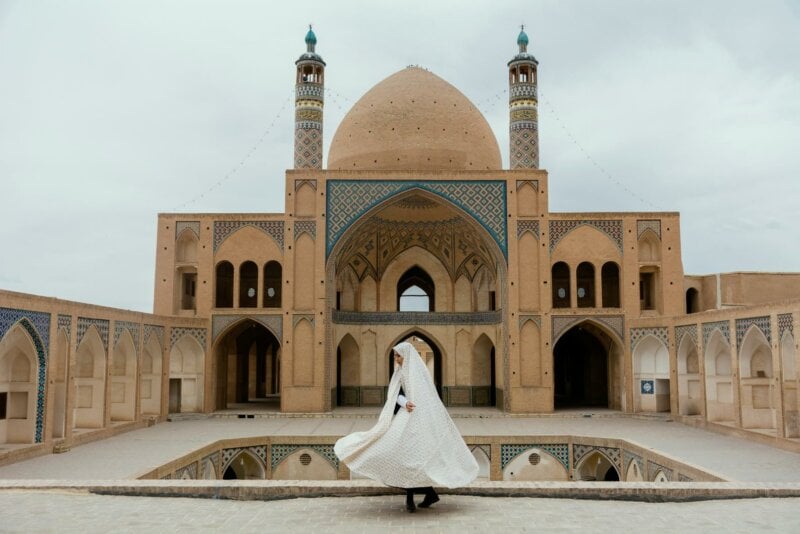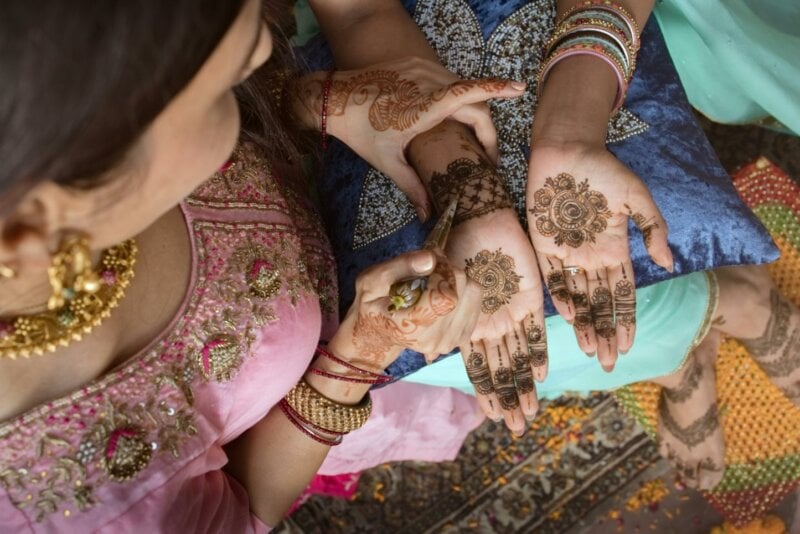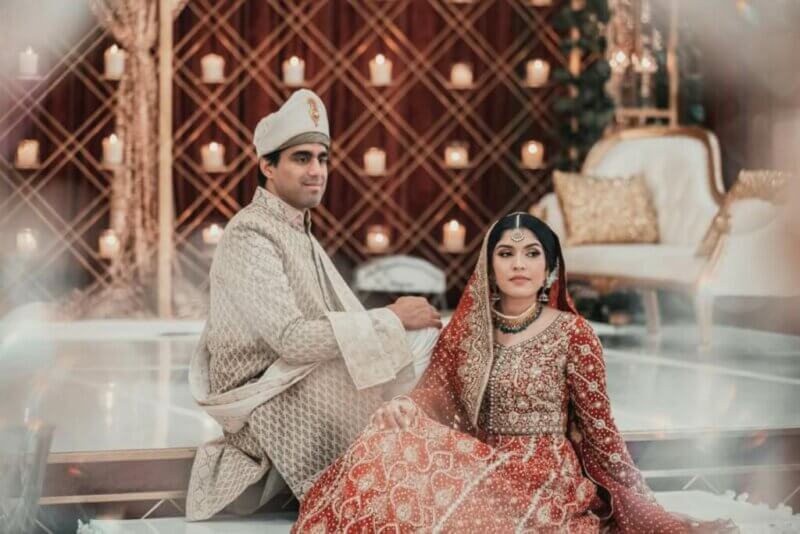Muslim Wedding Ceremony Guide


Muslim wedding ceremonies are intimate and romantic, and also filled with incredible rituals and traditions that make them wonderful and joyous occasions.
If you’re planning your own ceremony, you might not be sure where to start. Who do you ask to arrange one? Does a ceremony contain a religious service? What’s the order of a Muslim wedding ceremony? What traditions do you want to include and which might you want to adapt?
And, did you know that Muslim wedding traditions vary depending on region?
There are so many questions that if you’re planning your own wedding ceremony it can be complicated and confusing. However, the good news is that it doesn’t have to be. We’re here to answer all of the common questions and make your wedding planning a breeze.
So, in this post, we’re going to go into detail about everything to do with Muslim wedding ceremonies, from how long they last to what happens before, during and after.
What is a Muslim wedding ceremony?

A Muslim wedding ceremony, also known as a nikah, is when a Muslim couple comes together to get married. The ceremony is filled with traditions and rituals, including readings from the Qur’an.
Traditionally, the bride doesn’t need to be present at the nikah so long as she has previously given her express consent and permission. However, in many modern ceremonies, the bride often chooses to be there to share in the celebrations and spend time with her new husband.
What date should you have a Muslim wedding ceremony?

A Muslim wedding ceremony can take place on any day except for the two days of Eid, known as Eid al-Fitr and Eid al-Adha.
What time does a Muslim wedding ceremony take place?

There are no specific times for when a nikah should take place. However, it’s common for a nikah to begin around lunchtime, to ensure there’s still plenty of time for the Walima, which is a celebratory feast that usually takes place afterwards.
Is it common for Muslim weddings to include a religious service?

Yes, during the nikah there are many religious rituals and a sermon, which includes readings from the Qur’an.
How popular are Muslim wedding ceremonies?

As you might assume, Muslim wedding ceremonies are popular within the Muslim community. You can only get married in a nikah if both the bride and groom are Muslim.
What type of couples usually choose a Muslim wedding ceremony?

Because a nikah is so closely tied to Islam, only couples who are Muslim will choose to have a Muslim wedding ceremony.
Are Muslim weddings expensive?

According to our Canadian Wedding Report, the average cost of a wedding is around $30,000, which is similar to the average cost of a Muslim wedding. However, a wedding only needs to be as expensive as your budget allows. It’s entirely possible to have a beautiful Muslim wedding for about $6,500 or less. On the other hand, for a truly extravagant celebration, you might spend $55,000 or more.
How do Muslim wedding ceremonies vary across the world?

Islam is the second-largest religion in the world and spans different cultures and continents. This means, much like other religions, there are variations depending on which region you’re in.
For example, in Middle Eastern Muslim weddings, the bride is presented to the groom, while in South Asian Muslim weddings, the groom is presented to the bride. Similarly, in the Middle East, the Walima is the main post-ceremony celebration, while in South Asia there are two: the Shaadi and the Walima.
Who officiates a Muslim wedding ceremony?

A nikah is usually officiated by an Imam, who is a Muslim cleric, or sometimes a Qazi, an Islamic judge.
Is a Muslim wedding legally binding?

In Canada, a nikah ceremony conducted by an authorized officiant can fulfill both Islamic and legal marriage requirements. For a marriage to be legally recognized, it must be solemnized by an individual authorized under provincial or territorial law, such as a registered religious official or a marriage commissioner.
Therefore, if the nikah is performed by a registered officiant, it serves as both the religious and civil marriage ceremony. However, if the nikah is conducted by someone not authorized to solemnize marriages legally, the couple must also have a civil ceremony to ensure their marriage is recognized under Canadian law.
Where are Muslim wedding ceremonies held?

Couples have a wide range of options when it comes to where their nikah might take place. The traditional choice of venue is a mosque, the Muslim place of worship, before moving on to a separate venue in the afternoon and evening for the Walima.
Other couples may choose to get married in different venues, such as a home, hotel or venue space.
How long are Muslim wedding ceremonies?

The nikah will usually last between 30 and 45 minutes, though this can vary depending on the Imam and the number of traditions the couple chooses to incorporate into the ceremony.
What words are exchanged at a Muslim wedding ceremony?

Traditionally, at the nikah, there aren’t many words exchanged between the bride and groom, including vows. Some couples may choose to include vows in their ceremony, but the main word spoken by the couple is the repetition of the word qubool, which means I accept.
If the couple has chosen to exchange vows, there are no legal declaratory or consenting words, so they’re free to be as personal as they like.
Do men and women sit apart at a Muslim wedding ceremony?

Traditionally, men and women will sit apart at a nikah. In some ceremonies, the men and women may even sit in separate rooms.
However, this all depends on your beliefs, culture and preferences. Many modern nikah take place with no gender segregation.
What traditions are there at a Muslim wedding ceremony?

As we’ve already highlighted, there’s a wide range of traditions that take place during Muslim wedding ceremonies. These traditions also differ depending on where in the world you’re from. Below are just some of the most popular nikah traditions from different regions.
South Asian nikah traditions
- Mehndi. A pre-ceremony event that brings the bride together with female guests who will design henna patterns on the bride’s hands.
- Reading from the Qur’an. The first chapter of the Qur’an is read, called Surah Al-Fatihah.
- Arsi Mushaf. A mirror is held between the bride and groom so the groom can see his bride’s face.
- Baraat. Traditionally, the groom enters the ceremony on the back of a white horse. However, many modern-day grooms choose a car or carriage.
- Joota Chupai. A fun tradition that involves guests hiding the groom’s shoes and holding them until the groom pays a fee.
Middle Eastern nikah traditions
- Tolbe. Before the ceremony, the groom asks the bride for her hand in marriage, which is known as the Tolbe.
- Maher. The Maher is a gift given by the groom to his bride as a gesture of respect and to mark her independence.
What do you wear at a Muslim wedding?

Traditionally, a Muslim groom would wear an embroidered kurta, a collarless tunic, with pyjamas or churidars. At modern Muslim ceremonies, the groom may choose a sherwani, a long-sleeved coat.
Muslim brides will traditionally wear a salwar kameez, a beautiful combination dress, with a dupatta to cover her head. Other brides may choose to wear a saree or scarf to cover their head.
Guests are expected to dress modestly and avoid bare arms. If the nikah takes place at a mosque, guests will also be asked to remove their shoes as a sign of respect.
What is the order at a Muslim wedding ceremony?

A nikah usually sticks to a relatively set order, so you’re likely to find that any Muslim wedding you attend will follow the same sort of structure. They do allow for some personalizations, but not as many as other types of wedding ceremonies.
Nikah will follow an order that resembles the following:
1. The tolbe
Ahead of the ceremony itself, the tolbe takes place. This is a short meeting between the groom and the bride’s parents when he asks them for permission to marry their daughter. After receiving permission, everyone joins in saying a prayer called Surah Fatiha.
2. The mehr
A little bit like a traditional dowry, the mehr is a gift given to the bride by her groom. Many brides consider an engagement ring to be the mehr, but if not, she’ll be presented with a gift or money before the ceremony.
3. The consent
The bride and groom are asked three times about whether they consent to the marriage. Each time, they must say qubool hai, which means I accept.
4. The Nikah-Namah
The Muslim marriage contract is called the Nikah-Namah, which the bride and groom both sign. It’s then read aloud by the officiant so all the guests can hear the promise they’re making to each other.
5. The readings
The officiant will read verses from the Qur’an in a short sermon. This is the point when the bride and groom are declared married.
6. Savaqah
The final part of nikah is Savaqah, when gifts are given. This includes throwing money at the bride.
How do you book a Muslim wedding ceremony?

Once you’re engaged and looking to plan your nikah, speak to the imam at your local mosque. They can work with you to decide on a date that’s available so you can begin to plan everything else around it, such as a venue for the Walima, transport, decor, flowers and more.
Who plans a Muslim wedding ceremony?

Traditionally, the parents play a heavy role in planning a nikah. However, many modern Muslim couples like to plan their own wedding, but still welcome input and suggestions from both sets of parents.
Alternatively, you may want to hire a wedding planner, who can take a lot of the work from you.
What comes after a Muslim wedding ceremony?

Traditionally, following the nikah, the bride and groom join their guests for the Walima — a celebratory event similar to a wedding reception. Unlike typical receptions, however, a Walima can be an extended celebration, sometimes lasting up to two days.
In many cases, the Walima is held right after the nikah, on the same day. But depending on personal preferences and circumstances, it may also be scheduled for the following day or even two days later.
Plan your wedding ceremony with Bridebook
Looking to plan your own nikah? Sign up to Bridebook and get access to everything you need to plan your dream celebration.
You Might Also Like…
- 10+ Inspiring Love Quotes for your Wedding Day
- How Much Does Wedding Catering Cost in Canada?
- The Ultimate Canadian Wedding Budget Breakdown


